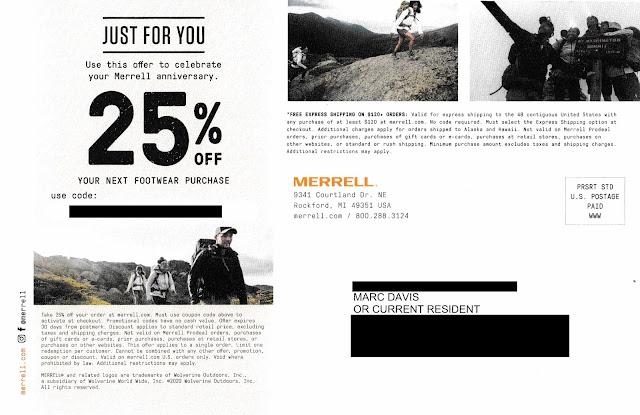This small postcard from rest.com merits a Fail for Content and Offer.
 |
| Can you find the call to action in 3 seconds? |
It's said that the eyes convey emotion, tug at hearts and show joy. So why does the front of this small postcard have a picture of a man with no eyes and the top of his head cut off? I guess Rest decided they couldn't fit the most important part of the human face on their postcard.
The call to action (CTA) is in knock-out white text over a light-colored comforter, making it hard to see. It is in the bottom left corner, which is that the last corner a reader scans. The "HSA/FSA Eligible" message jumps, but the website name does not.
 |
| Small postcard with unreadable copy |
On the address side, we see the eyeless guy with an eyeless woman. (At least the woman is conveying some emotion with her smile.) Some sales messages are rendered in a font size legally too small for financial service disclosures, yet Rest mistakenly thinks it is large enough for a consumer to read with interest.
Below the marketing messages are some logos. The middle one is a Good Housekeeping symbol. I tried reading the others using my phone at 4x view. I think the one on the left is about health, but I don't know. Do you think a consumer would know or care?
The CTA is lost at the bottom in small type. The retail partners are listed in small knock-out white type over a mostly dark background. Five points to anyone who can name the retailer on upper right, because I can't.
The USPS allows for a postcard to as large as 6" x 9" to qualify for the standard postcard rate. Rest chose to make it only 4" x 6". Why? The only reason I can think of is to save a few bucks on paper for an otherwise expensive direct mail campaign. This approach is penny wise and pound foolish. Most of the visual problems could be solved with adequate space for content. Plus, a postcard this small gets lost in physical clutter.
Speaking of clutter: That's part of the problem with the postcard. There are too many messages. Rest is stuffing mention of 5,000 5-star reviews and a Good Housekeeping seal and two other logos I can't identify and something about being HSA/FSA eligible and retailers other than their website and one random testimonial. The core sales proposition is lost.
Going back to that CTA: It's simply to visit the website. There is mention of a potential 35% discount, but it is too hard to find, too hard to read and too far from the CTA. If I were to work on this postcard, I would advise Rest to include some kind of offer or value proposition next to a prominent CTA. "Enjoy up to 35% off through [date] at rest[dot]com/xxxx." The xxxx could be a URL developed specifically for this postcard, so you can at least gauge resulting traffic. But, of course, you need space to utilize this best practice.
Lessons:
- When mailing a postcard, take advantage of the largest size available at postcard rate.
- Avoid content with inadequate background color contrast.
- All your sales copy should be large enough for a typical consumer to be able to and want to read.
- Avoid overloading your mail with too many messages.
- Your call to action should be easy to find.
- Your call to action should include a reason to take action now.
- Include a means of tracking your mail's performance.
- Depicting people without eyes is creepy.


.png)
.png)













